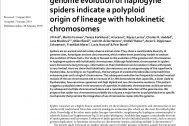Obsah
Spiders are an ancient and extremely diverse animal order. They show a considerable diversity of genome sizes, karyotypes and sex chromosomes, which makes them promising models to analyse the evolution of these traits. Our study is focused on the evolution of the genome and chromosomes in haplogyne spiders with holokinetic chromosomes. Although holokinetic chromosomes in spiders were discovered a long time ago, information on their distribution and evolution in these arthropods is very limited. Here we show that holokinetic chromosomes are an autapomorphy of the superfamily Dysderoidea. According to our hypothesis, the karyotype of ancestral Dysderoidea comprised three autosome pairs and a single X chromosome. The subsequent evolution has frequently included inverted meiosis of the sex chromosome and an increase of 2n. We demonstrate that caponiids, a sister clade to
Dysderoidea, have enormous genomes and high diploid and sex chromosome numbers. This pattern suggests a polyploid event in the ancestors of caponiids. Holokinetic chromosomes could have arisen by subsequent multiple chromosome fusions and a considerable reduction of the genome size. We propose that spider sex chromosomes probably do not pose a major barrier to polyploidy due to specific mechanisms that promote the integration of sex chromosome copies into the genome.
Dysderoidea, have enormous genomes and high diploid and sex chromosome numbers. This pattern suggests a polyploid event in the ancestors of caponiids. Holokinetic chromosomes could have arisen by subsequent multiple chromosome fusions and a considerable reduction of the genome size. We propose that spider sex chromosomes probably do not pose a major barrier to polyploidy due to specific mechanisms that promote the integration of sex chromosome copies into the genome.



